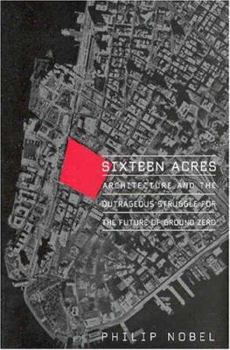Sixteen Acres: Architecture and the Outrageous Struggle for the Future of Ground Zero
Select Format
Select Condition 
Book Overview
"Quirky, discursive, and highly opinionated" - a frank and devastating assessment of architecture and the rebuilding at Ground Zero (Michiko Kakutani, The New York Times ) Maverick architecture critic... This description may be from another edition of this product.
Format:Hardcover
Language:English
ISBN:0805074945
ISBN13:9780805074949
Release Date:January 2005
Publisher:Metropolitan Books
Length:304 Pages
Weight:1.06 lbs.
Dimensions:1.1" x 5.7" x 8.6"
Customer Reviews
2 ratings
"Architecture is the art of compromise''
Published by Thriftbooks.com User , 18 years ago
`'Sixteen Acres. Architecture and the outrageous struggle for the future of Ground Zero'' by Philip Nobel. `'Architecture is the art of compromise.'' Daniel Liebeskind One of the top architecture critics , Philip Nobel takes the readers of his book on an amazing trip, deep into the world of `' the outrageous struggle'' among architects, politicians, developers and businessmen responsible for the rebuilding of Ground Zero in order to fill in the void that has been created at those sixteen acres. It has been an enriching and at the same time interesting experience to read it. This non- fictional account of what has been happening behind the scenes at Lower Manhattan among some crucial players in this game like Larry Silverstein, Port Authority, the LMDC, Governor George Pataki and other politicians or members of families who lost their loved ones in the tragedy, in fact reads like an extraordinary novel. With his in- depth analysis and an incredibly realistic style of writing, his work can be easily understood not only by professionals but those who know nothing about architecture as well. The book artfully blends some historical information about architecture together with real dramatic life events and very often shocking, hair-rising gossip. As Liebeskind puts it, you need compromise in order to design and create new buildings, ones that will `' speak the unspeakable'' and fairly fill in the void, and at the same time satisfy everyone's needs and wishes. Can this actually be achieved in real life? With so many players involved it might turn out to be a pretty difficult task. Who is the winner and who looses? The book written by Nobel is a great eye-opener shedding new lights on this controversial issue of rebuilding Ground Zero. To put the message across the author decided to divide the book into twelve chapters devoting extra space for prologue and epilogue. Starting with the description on Ground Zero, touches upon some architectural streams in the past. The plot is expanded with every chapter, rising climax in middle chapters speaking of the competition and actual struggle. At first it seems almost incredible how by chance the star architects like Gehry or Koolhaans just happen to be in New York when the attack happens. Many designers make numerous trips to the site in order to understand, contemplate, explain, search for reasons and answers. Was the void indeed fixable? Or maybe it should remain intact. Questions were piling up. As Giedion puts it buildings are `' human landmarks which men have created as symbols for their ideals , their aims, and for their actions''. The commercial buildings of WTC represented so many ideals, standing symbolic and triumphant in the skyline of the city. `'Buildings bear silent witness to what we do'' Nobel suggests, they are our immortality on the earth and they
A lip lock with reality
Published by Thriftbooks.com User , 18 years ago
Sixteen Acres is a gripping read for any architect or citizen who hopes that a monumental building in this era can be transcendent. No where have I seen such a thorough accounting of the forces that come to bear on the form of a building. Sixteen Acres is the record of how the desire of the American people to find an expression for the loss they suffered-or the telling off they wished to do-was shaped by the many powerful forces that acted on the site: Governor Pataki's aspirations, the widows', the mayor's, the LMDC, the Port Authority, Larry Silverman's 99 year lease. The book is truly about the profession of "architecture and the outrageous struggle for the future of Ground Zero." As Mr. Nobel says "...architecture remains the most prominent and most culturally engaged of all the arts. It is also the most contingent-an art that is neither high nor low, an art that gets to art only after locking lips with reality: satisfying a client, securing funds and permits and insurance, getting built." This book paints the lip lock in glowing detail. He has the wisdom to recognize that at the end of the day "...when the politicians line up to cut their ribbons, whatever [building] shades the dais that day will be at once stranger and more fitting than anything they had imagined when they set about to govern its birth. In a way it will be perfect." For young architects and those who think design is about the power of their vision, this eye-opener will help them see that in addition to having their vision, they must also design the process; that is, they must so understand the interests of the various parties that they can target the area of the overlap. In that area, on any particular job, will be the perfect solution.




